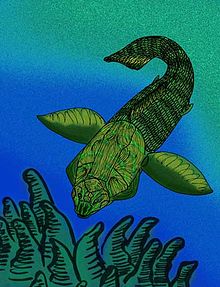Holonematidae
| Holonematidae Temporal range: ?Emsian to Frasnian |
|
|---|---|
 |
|
| Holonema rugosum | |
| Scientific classification | |
| Kingdom: | Animalia |
| Phylum: | Chordata |
| Subphylum: | Vertebrata |
| Class: | Placodermi |
| Order: | Arthrodira |
| Family: | Holonematidae |
| Type species | |
| "Pterichthys rugosum" Claypole, 1883 |
|
| Genera | |
|
|
Holonematidae is an extinct family of relatively large arthrodire placoderms from the Early to Late Devonian. Almost all fossil specimens are of armor fragments, though, all have distinctive ornamentation, often of unique arrangements and patterns of tubercles, that are diagnostic of the family. The trunkshield is very elongated, giving the armor an overall "barrel" like appearance.
Due to pebbles found inside articulated specimens of the Frasnian species, Holonema westolli, holonematids are thought to have been specialized herbivores that grazed on a form of horn-shaped, stony algae called "onycholite," snipping off the tips with their odd snouts.
A poorly known genus from the Givetian-aged Blacourt Formation of Boulonnais, France. The holotype of Artesonema is an anterodorsolateral plate from an adult that has an ornamentation of tubercles normally characteristic of juvenile holonematids.
Belemnacanthus is from the Givetian of Eifel, Germany. It has been previously described as being an elasmobranch, an agnathan, and an antiarch. The genus is known only from the holotype: a 37 cm long portion of a median dorsal plate, suggesting a very large animal. The median dorsal plate has a long crest running down the median of the dorsal surface. The outer surface has an ornamentation of long ridges radiating from a point beyond the preserved portions.
If Bimbianga is a holonematid, then it is the earliest genus, dating from the Emsian-aged Taemas Limestone of Wee Jasper, New South Wales. Bimianga's placement within Holonematidae is questionable, as the morphology of its plates and ornamentation are very similar to those of the arthrodire incertae sedis Aspidichthys.
...
Wikipedia
